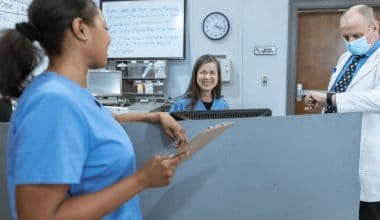Becoming a licensed practical nurse (LPN) is one of the ways you can start a career in the healthcare field. One may ask, how long does it take to become an LPN? If you are one, then you are definitely in the right place to know how many years you will spend in the classroom to become a Licensed Practical Nurse (LPN).
Despite popular belief, it doesn’t take years in the classroom to become a Licensed Practical Nurse (LPN). Taking an LPN course is the fastest method of becoming a nurse. According to the US Bureau of Labor Statistics, employment of licensed practical and licensed vocational nurses is projected to grow 11 percent from 2018 to 2028. This is much faster than the average for all occupations.
Therefore, in this article, you will get detailed information on how long it takes to complete an LPN school program, the requirements, prerequisites, and steps to become one.
Table of contents
- Who Is A Licensed Practical Nurse – LPN?
- How Can I Become A Licensed Practical Nurse?
- How Long Does It Take To Become A Licensed Practical Nurse – LPN?
- What Should I Expect In An LPN Training Program?
- What Are The Requirements To Enrol For An LPN Program?
- LPN Program Coursework And Practical Rotations
- How Much Does An LPN Make?
- How Do I Become Licensed As A Practical Nurse?
- Conclusion
- References
Who Is A Licensed Practical Nurse – LPN?
A licensed practical nurse is a nurse who cares for people who are sick, injured, convalescent, or disabled. LPNs cannot work independently and are guided by RNs and doctors. Rather, they assist registered nurses and provide basic patient care.
An LPN is sometimes called a licensed vocational nurse (LVN) in some parts of the United States, such as Texas and California.
Regardless of their name, nurses in these roles usually comprise a team of health professionals who provide care in various settings.
Typically, LPNs monitor a patient’s vital statistics, administer basic care, and also report concerns to registered nurses and physicians.
The duties of a Licensed Practical Nurse include but are not limited to the following:
- Administering injections
- Measuring blood pressure, pulse, and temperature, and monitoring the rate of respiration.
- Collecting samples for testing and recording fluid intake and output.
- They assist in nursing wounds, dressing, and also providing medications.
- In addition, monitoring the effectiveness of the patient care plan.
- Explaining the probable options and providing a morale boost to patients who face physical and emotional challenges after treatment.
The functions of LPNs may differ depending on the state. However, some selected states may allow them to assist in surgeries or participate actively in team discussions where the aim is to deliver the best care to the patient.
How Can I Become A Licensed Practical Nurse?
Basically, to become a licensed practical nurse, you need to get a certificate or diploma from an accredited LPN program. Nevertheless, below are the steps to becoming a licensed practicing nurse:
- Decide whether to earn a diploma, certificate, or degree.
- Complete an approved education program.
- Pass the NCLEX-PN
- Seek professional certification
- Enter the Workforce
- Consider additional training
Want to pursue a Licensed Practical Nurse Program? Then, see these Top 20 Affordable Online LPN Programs
How Long Does It Take To Become A Licensed Practical Nurse – LPN?
To become an LPN, you must complete a state-approved training program, often in the form of a diploma, certificate or associate degree. Most full-time licensed practical nurse (LPN) training programs typically take around 1 year (12 months) to complete with an accumulation of 36-40 credit hours of coursework.
The length of the program can vary from state to state. Although the majority of programs can be completed in one year, some LPN programs offering an extensive nursing curriculum may take longer. Conversely, accelerated programs can be completed in as few as nine (9) months.
On the other hand, continuing education can take up to 5 years or possibly longer.
Before we go ahead, as a student, you need a GUIDE. Check out the numerous Tips For Students available on our platform.
What Should I Expect In An LPN Training Program?
Several schools offer extensive training to LPNs as this profession deals with the lives of the people. The LPN training program is carried out in two phases:
- Classroom Study
- Supervised Clinical Practice
In classroom training, future LPNs get to acquaint themselves with the basic terminologies and theoretical concepts. Meanwhile, in the supervised clinical practice, they get opportunities to work in real work settings, under the guidance of doctors and RNs.
Typically, to enroll in a school for a licensed practical nursing program, you need a high school diploma or GED certification. Most LPN training programs are available through vocational-technical schools and community colleges and usually result in a certificate or an associate’s degree. The LPN training, in turn, allows the graduates to seek entry-level positions.
However, in order to be a practicing nurse, LPN program graduates are to take the NCLEX-PN exam, which grants the graduate the LPN license.
To be eligible for licensure, your program needs to be state-approved. The National League for Nursing Accreditation Commission lists accredited practical nursing programs. We, therefore, advise future practical nurses to ensure the check with their specific state’s board of nursing as well.
Furthermore, graduates can choose to take a transitional training program to become a registered nurse (RN) or complete a bachelor’s degree in nursing. Both options are also available as bridge programs, meaning many existing credits may transfer into a new program.
Countries Where LPN Exist
Yes, Licensed Practical Nurses exist in other countries most times as different names.
In Australia, they are referred to as Enrolled Nurses who do a two-year course. In Canada, the Practical Nurse (PN) education is basically the old two-year diploma RN coursework.
Spain has nursing auxiliaries. However, you would need to be fluent in written and spoken medical Spanish.
In the UK, England to be precise stopped training Enrolled Nurses in the late 80s and upgraded their ENs via an educational route to SRNs. Currently, they have health aides on the wards.
Would you love to continue education, then check out these 13 Affordable Online LPN to RN Programs for Nurses
What Are The Requirements To Enrol For An LPN Program?
Basically, to enrol for an LPN training program, an aspirant must have completed high school or have passed the General Educational Development (GED) exam. He or she should have also attained 18 years of age
To enrol for a Licensed Practical Nursing training program, below are the basic requirements aspiring LPNs must fulfil:
- A valid photo identification.
- Candidates must not be involved in any illegal practice and should have no criminal record.
- The candidate is required to pass the drug test successfully.
- Certified Nurse Aide (CNA) licensure and completion of a nursing assistant program.
- Physical exam administered by a licensed doctor.
- Cardiopulmonary resuscitation (CPR) certification.
Most LPN schools have prerequisite classes needed to be completed in order not to only get into a program but to also receive a certificate or degree from it. They include but not restricted to:
- Psychology
- Computer skills
- Health Sciences
- History
- Math
- Social studies
- English
- Biology
LPN Program Coursework And Practical Rotations
Basically, LPN programs include general education classes, such as composition and psychology. Also, students usually take core classes in anatomy and physiology, which include lab components.
LPN Coursework may also cover:
- Maternal and child health
- Family nursing
- The role of the LPN on the health care team.
- Administration of Medications
- Legal and Ethical Responsibilities
- Nutrition
- Common Diseases
- Rehabilitative and Restorative Nursing Care
- Cultural Differences in Caring for Patients
- Leadership Principles
In addition, students spend a significant number of hours practising in a hospital, clinic, nursing home, or health facility as part of the clinical rotation requirement.
As an aspiring LPN, you will need this; 10 Most Useful Website Online for Nursing Students
How Much Does An LPN Make?
According to the US BLS, the median annual wage for licensed practical and licensed vocational nurses is $46,240. That is, LPNs earn $22.23 per hour.
On the other hand, Glassdoor reports that LPNs earn a national average salary of $41,917 in the United States. Meanwhile, according to Payscale, the average salary of an LPN is $43,737.
How Do I Become Licensed As A Practical Nurse?
As earlier explained, to practice as an LPN in the USA, you must take and pass the NCLEX-PN exams. The National Council of State Boards of Nursing offers the National Council Licensure Examination for Practical Nurses (NCLEX-PN).
To take the exam, LPNs need to apply for eligibility from their state’s board of nursing. Some states require that LPNs demonstrate education and also work experience prior to receiving the license. On the other hand, others require only that they pass the NCLEX-PN exam. Therefore, as an LPN graduate, we advise you to check your specific state’s requirements.
After confirming your eligibility through your specific board of nursing, then, you can schedule a time to take the national exam. With a passing score, you will be a licensed practical nurse able to work in the jurisdiction of the board through which you sought licensure. However, if you move to another state, you may have to reapply for licensure.
In a situation where a candidate does not pass the NCLEX-PN on her first attempt, he/ she can still try again. However, the candidate will have additional fees.
Nevertheless, some states allow candidates to work under a temporary permit while they are waiting to test, but rescind the privilege for those who don’t pass the first time around.
What Is The NCLEX-PN Licensing Exam?
The NCLEX-PN examination is usually the last step before licensure. It is a computer-based test and is given at centers around the country. Therefore, a candidate does not need to test in the state where he/she is seeking licensing. Rather, the candidate is to make sure that he/she schedules the exam during the window granted by his/her authorization to test.
Basically, the NCLEX-PN test covers 4 main categories:
- Safe And Effective Care Environment: Management of care, safety, and infection control
- Health Promotion and Maintenance: Growth and development through the lifespan, prevention, and early detection of disease
- Physiological Integrity: basic care and comfort, pharmacological and parental therapies, reduction of risk potential
- Psychosocial Integrity: coping and adapting, and psychosocial adaptation
To take the NCLEX, a candidate will first need to complete two separate processes (this is only applicable to nursing regulatory bodies of the U.S. & Canada):
- Contact your Nursing Regulatory Body (NRB)
- Request a licensure/registration application
Applicants are to pay a licensing/registration fee to the NRB along with the submission of your application materials.
In addition, licensure/registration applications must be obtained from the NRB in the state/province/territory where you are seeking licensure/registration, as requirements vary.
To register for the NCLEX-RN exam, candidates are to pay a licensing fee of $200. However, additional licensure fees are determined by the individual State Boards of Nursing.
For more information on the examination, visit the link below:
Want to know where you can work with an LPN degree? Then see this; Types of Nursing Majors | Where can I work with a Nursing Degree?
Conclusion
Enrolling in an accredited school for LPN training program is the fastest method of becoming a nurse. The interesting fact about becoming an LPN is that the diploma or certificate can be gotten within a year. In addition, an LPN career in the nursing profession is a promising one following the expected increase in the job prospect and the salaries provided above.
Therefore, I hope the information here helps you in making your decision.
Good Luck And Success!!!
References
- Wikipedia – Licensed Practical Nurse
- LearnHowToBecome – How To Become A Licensed Practical Nurse: Lpn/Lvn Programs & Careers
- Learn.org – How Long Does IT Take to Become a Licensed Practical Nurse (LPN)?
- Study.com – How Long Is Nursing School?
- TopRegisteredNurse – LPN Nurses: Basic Requirements, Training, Work Environment, Areas of Practice, Career Outlook, and Salary
- LPNOnlineClass – How Many Years of School To Become an LPN After High School
- Athena Career Academy – How Long Does It Take to Become an LPN?
- NursingLicensure – How to Become an LPN: Start Here for Licensed Practical Nurse Requirements
- AllNursingSchools – Licensed Practical Nursing: Education Requirements, Career Paths & Job Outlook
- AllNurses – LPNs in other countries?
- USBLS – Occupational Outlook Handbook Of Licensed Practical and Licensed Vocational Nurses




